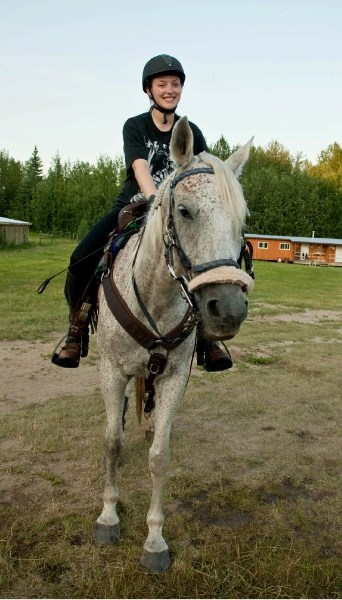With an early rise and a long hot journey ahead of them, 40 riders headed out for an endurance competition at Horse Creek Ranch Saturday, July 7.
Endurance riding takes horseback riding to whole different level, with distances in this particular competition of 25, 50, 75, and 100 miles. It was an early rise for every rider and horse, as the 75 and 100-mile riders began their journey at 5 a.m. The next group of riders started an hour later, and as 7 a.m. rolled around the 25-mile riders entered the trails too.
Participants have seven hours to complete the 25, 12 hours to complete the 50, 18 hours to complete the 75 and 24 hours to complete the 100 miles. Within these times there are mandatory holds, in which riders are required to rest their horses. During these rests they water down their horses, feed them, and prepare them for the next loop.
The sand on the trails makes the ride a very technical one, said ride manager and past president of Endurance Riders of Alberta Brenda Henrikson. The deep sand is quite hard on the ligaments of the horses, so riders need to be very careful.
“It’s not the easy ride that some people think it is,” she said. “But the trails are beautiful.”
“To finish is to win” is the motto of endurance riding. Although it doesn’t matter whether it takes eight hours or two, the race is one you want to make sure your horse is able to complete, said Henrikson. This is why the competition is so controlled with vets and stops.
At every stop vet Deanna Spiker, who has 18 years of vet experience under her belt, was in charge of judging each horse by checking their pulse, trotting them to see if they’re still bright and perky, checking their skin, gut sounds, and muscles for cramping or weariness.
The vet’s job is to make sure the horses are safe and healthy after each loop, and if they aren’t to stop them from going any further. Although Spiker said sometimes it’s hard for the rider to know the state of their horse while they’re riding, most riders in this sport are great with their horse and stop before injury occurs.
“If they’re lame or they’re starting to get too tired or dehydrated, we stop them and that’s it,” she said. “[Riders] are just as willing to stop their horse as you are to stop it.”
Spiker said a lot of the horses were more tired than they would have been normally because of the heat, and there were a few horses that wound up being lame because of muscle cramping. However other than that she said the horses did pretty well.
Awards were given for first to fourth place in each speed division, but perhaps the most cherished award is Best Condition. During the competition, each rider carries a vet card with them on which they are scored by the vet during their rest stops. The weight their horse was carrying, how the horse finished the race, how long their ride was, among other factors are all taken into consideration.
“That’s a really coveted award, to be given best condition,” said Henrikson.
Henrikson said the rider turnout for the competition this year was a good one, considering the hot weather and bugs.
“It was hot and tiring. We all got a little roasted, and the bugs drove the horses crazy,” said Henrikson. “But we didn’t have any injuries, we didn’t have any accidents, no horses ended up with any health issues. That’s a good day.”



